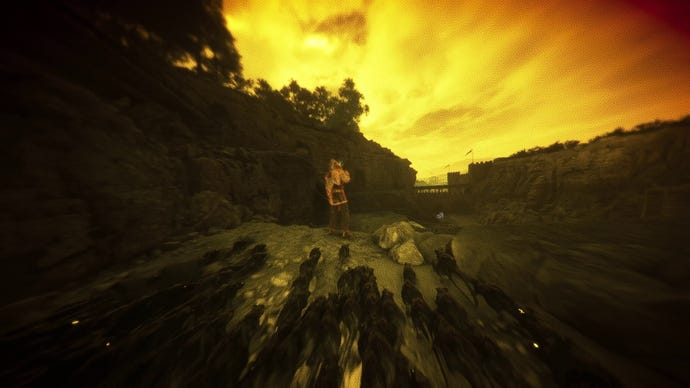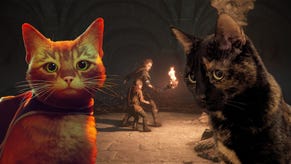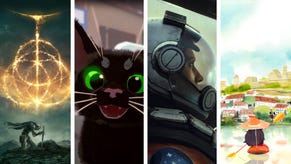A Plague Tale: Requiem review: a feast for the eyes, but its storytelling lacks bite
The Black Death has been brought back to life
The last time we saw Amicia and Hugo de Rune in A Plague Tale: Innocence, the two homeless orphans were escaping the clutches of the Inquisition, trying desperately to find a cure for the cursed Prima Macula in Hugo’s blood. They were also fighting for their lives against thousands of bloodthirsty rats eager to devour them. These two have lived through more danger and trauma than anyone should have in a thousand lifetimes, and after the first game’s sort-of happy-ish ending, it got me thinking: when will these kids ever catch a break?
Turns out the answer is never. Asobo’s follow-up A Plague Tale: Requiem is just as gory and bleak as its predecessor and as the siblings continue to battle through a violent world that wants them dead, they'll both face difficult moral decisions in the name of survival. Oh, and there are more rats. Like, a lot more rats.
In Requiem, the duo are forced to flee their homeland and travel south, still trying to find a way to control Hugo’s supernatural power that allows him to control the rats. The two are searching specifically for an island that has appeared in Hugo’s dreams in the hope that it holds the key to saving him from his affliction. It’s a long shot, but it’s the only lead they’ve got.
Much of what you'll be doing is the same as the first game, lots of sneaking around, taking out soldiers with Amicia’s sling, using different alchemy combinations, and deviously manipulating the horde of rats to work in your favour. It's all very familiar, but Requiem expands on many of these features making for a bigger, bleaker sequel.
.jpg?width=690&quality=80&format=jpg&auto=webp)
From the game’s very first scene, it's obvious that Asobo have really focused on spectacle with Requiem. Innocence was set on the backdrop of a bleak war-torn France - complete with blood-soaked battlefields and diseased-stricken cities - and although Requiem is also dark and grim in its outlook, Asobo have given the series a major glow-up. I was consistently struck by how gorgeous Requiem is. Sure, there are still plenty of disgusting rat nests and corpse-filled cities that make my stomach turn, but there are also quaint medieval towns, pebbled beaches, lavender fields, and rolling oceans. In beauty or ruin, environments look gorgeous.

A new skill automatically unlocks extra abilities suited to your playstyle. If you're more sneaky-sneaky you can unlock skill perks that lets you make less noise when moving, but if you're more aggressive there's another set of perks that lets you shove enemies into open fire and rat nests. Yikes.
The sibling’s surroundings may have somewhat improved in the sunny south of France, but their predicament has never looked bleaker, and it’s not long until the real stars of the show arrive, in all their tiny, toothed glory. This time, though, Amicia has a lot more tools at her disposal. Your trusty sling is back, letting you carefully and accurately throw rocks and alchemic powders to distract or dispose of soldiers. Staying close to a light source and finding the best patch of long grass to hide in are still key to survival, but with bigger set pieces it feels like you're actively picking your own route and playstyle through the danger instead of following what's been laid out before you.
How aggressive you want to be is still completely up to you. Lobbing a rock at a chest full of metal armour to draw a guard's attention is one way, or extinguishing their torch light and plunging them into darkness so the rats can feast upon their body is, uh, certainly another.

The tension between violence and justice was something I loved in Innocence and, as Katharine noted in her preview, it's a continuing ethical dilemma that the kids must grapple with in Requiem. Amicia’s arsenal in Requiem now includes a deadly crossbow, a knife that can be used to rapidly stab soldiers to death, and tar that burns when it makes contact with an open flame - incredibly useful for taking out heavily armoured soldiers. All three are quick, aggressive, and difficult to watch unfold.
.jpg?width=690&quality=80&format=jpg&auto=webp)
I just really wanna shout out Charlotte McBurney who plays Amicia real quick. The energy and pure ferocity she brings to the role is pretty incredible. Be prepared to have your heartstrings well and truly yanked.
What’s interesting in Requiem is that it's not just teenage Amicia having to confront the ethics of her actions, but Hugo as well. The five-year-old still has the power to control the rat horde, an ability he discovered near the end of Innocence, and he uses it multiple times to devastating effects. As the two get more desperate to protect themselves, Amicia starts to become more aggressive and is also forced to watch her brother walk down the same violent path. If the first game was about two estranged siblings getting to trust each other, Requiem is about how this ethical dilemma is pushing them apart.
It feels like this escalation is heading toward some sort of a conclusion, but unfortunately it fizzles out at the game's mid-point as the story becomes more concerned with the duo finding Hugo's cure. It's an unexpected change in direction that puts the story on uneven footing. The emotional payoffs throughout the rest of the game still hit home, but it’s a shame they don't explore the idea in more depth, especially when both Innocence and Requiem stake so much on the bond between the two siblings. At least there's no rat pope, though.
.jpg?width=690&quality=80&format=jpg&auto=webp)
Other storytelling gripes involve Requiem’s new cast. Amicia and Hugo's mother Beatrice makes a return from the last game, as does Lucas, a young alchemist who tries to help the two siblings keep on a moral path. However, these familiar faces are quickly swapped out as Requiem introduces other new characters. The first is enemy-turned-friend Arnaud, a knight who will charge into battle for the siblings when instructed, adding yet another violent option to Amicia's arsenal. The second is pirate lass Sophia, who can set grass on fire with her mirror to distract guards and acts as emotional support for the two kids in a handful of moments.
Mechanically, both add interesting options to how you deal with the game's sneaky-sneaky parts, but story-wise they're rushed in so fast that they never felt like they had much groundwork, meaning I didn't feel as attached to this new gang as I did to the group of rag-tag scamps at the end of Innocence. In fairness, I ended up really liking Sophia towards the end of the game (she's got that 'looks evil but is actually a cinnamon roll' vibe that's completely endearing) but it doesn't stop both her and Arnaud feeling like empty vehicles to deliver fun new abilities instead of fully rounded characters.
.jpg?width=690&quality=80&format=jpg&auto=webp)
.jpg?width=690&quality=80&format=jpg&auto=webp)
.jpg?width=690&quality=80&format=jpg&auto=webp)
.jpg?width=690&quality=80&format=jpg&auto=webp)
Requiem is certainly a dazzling display of detail, colour, and considerate art direction but it never quite reaches the momentum of its predecessor even though the stakes are unequivocally higher. Huge set pieces and a wider selection of abilities make sneaking through soldier and rat-infested areas feel like a thrilling, if slightly repetitive challenge, but Requiem’s story fails to hold the same level of drama and spectacle.
.jpg?width=880&quality=80&format=jpg&auto=webp)














